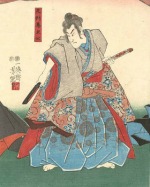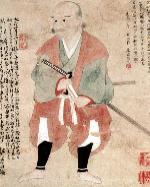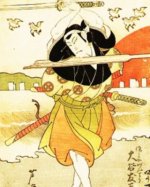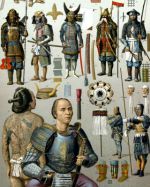The Duels of Miyamoto Musashi
Talk the Talk
As well as being a great warrior and writer, Miyamoto Musashi was
also a renowned painter.
As an artist of suiboku-ga, or sumi-e,
(monochrome ink painting), Musashi painted much how he fought, with a powerful and direct style that utilized a remarkable economy
of movement.
Of particular note were his paintings of birds such as Koboku Meikakuzu (Shrike Perched in a Dead Tree) and Rozanzu
(Wild Geese among Reeds), and a famous self-portrait he did in c.1640 (pictured right).
Walk the Walk
Musashi rarely washed as he believed the act of bathing put him in a vulnerable position and unlike most samurai warriors,
he dressed in rags.
It can be argued that this tramp-like appearance served to anger his opponents who would have seen it as disrespectful to turn up to face them in such a manner.
Others would have underestimated him because of his appearance, either of which would have had a negative effect on their ability to fight to their maximum potential.
It can be argued that this tramp-like appearance served to anger his opponents who would have seen it as disrespectful to turn up to face them in such a manner.
Others would have underestimated him because of his appearance, either of which would have had a negative effect on their ability to fight to their maximum potential.
Samurai Quote
Those who sincerely desire to learn my way of strategy will follow these rules for learning the art:
1. Do not harbour sinister designs. Think honestly and truthfully.
2. The Way is in training. One must continue to train.
3. Cultivate a wide range of interests in the ten skills and ten arts. Then one can definitely find the benefits of hyoho and develop oneself.
4. Be knowledgeable in a variety of occupations, and learn the thinking of people who work in them.
5. Know the difference between loss and gain in worldly matters.
6. Nurture the ability to perceive the truth in all matters. It is important to build up an intuitive judgement and understand true values.
7. Be aware of those things which cannot be easily seen with the eye. Develop intuitive judgement and a mind that freely controls one's body.
8. Do not be negligent, but pay attention even to the smallest details. Keep them in mind all the time, so as to avoid unexpected failure.
9. Do not engage in useless activity. Do not argue about useless things. Concentrate on your duties.
~ Miyamoto Musashi ~
1. Do not harbour sinister designs. Think honestly and truthfully.
2. The Way is in training. One must continue to train.
3. Cultivate a wide range of interests in the ten skills and ten arts. Then one can definitely find the benefits of hyoho and develop oneself.
4. Be knowledgeable in a variety of occupations, and learn the thinking of people who work in them.
5. Know the difference between loss and gain in worldly matters.
6. Nurture the ability to perceive the truth in all matters. It is important to build up an intuitive judgement and understand true values.
7. Be aware of those things which cannot be easily seen with the eye. Develop intuitive judgement and a mind that freely controls one's body.
8. Do not be negligent, but pay attention even to the smallest details. Keep them in mind all the time, so as to avoid unexpected failure.
9. Do not engage in useless activity. Do not argue about useless things. Concentrate on your duties.
~ Miyamoto Musashi ~
Shinmen Musashi no Kami Fujiwara no Genshin, better known as Miyamoto Musashi is probably the most famous historical samurai today as a result of his highly acclaimed martial arts text, The Book of Five Rings.
His story has been told and retold down the ages and many of his ideas on fighting technique and strategy have become commonplace amongst warriors as a result of his teachings. He claimed to have fought in over sixty duels between c.1604 – 1613, dispatching all who stood in his way and building a reputation for himself as the finest swordsman in the country.
The Early Years of Miyamoto Musashi
Born in 1584 in Miyamoto village, much of the detail about Musashi’s childhood is obscure however it is known that he was born into a samurai family and probably grew up with his mother or stepmother. His father, Shinmen Munisai, was an accomplished warrior who would regularly visit his son and give him instructions on swordsmanship and other aspects of samurai culture.
However by the time he was around ten years old, Musashi’s mother was dead and his father had either died also or completely abandoned him, so he found himself living in a monastery where he learned Zen Buddhism from the monks there.
At the age of thirteen, he was already confident enough to challenge an older samurai named Arima Kibie of the Shinto Ryu (school). Arima made the mistake of disrespecting Musashi by treating him like a child, which resulted in Musashi throwing him on the floor and beating him with a six-foot wooden staff until his opponent died vomiting blood.
At sixteen Musashi left the monastery and it would not be long before he found himself fighting his second duel, which he won easily. Soon after he would face a tougher challenge when he fought in the Battle of Sekigakarai (1600) on the side of the Ashikaga Clan against the victorious army of Ieyasu Tokugawa.
Despite being on the losing side, he fought bravely and somehow managed to survive both the battle and the ensuing massacre of Ashikaga troops that followed it.
The aftermath of the Battle of Sekigakarai left Miyamoto Musashi in the position of being a master-less samurai (known as a ronin) so he began to wander Japan on a type of warrior pilgrimage known as a musha shugyo. During these years, he would hone his fighting skills and philosophy in a series of duels, many of which were to the death.
Miyamoto Musashi and the Yoshioka Clan
The young samurai began his pilgrimage by making his way to Kyoto in around 1604, where he would have a series of challenges against the heads of one of the most notorious schools in the city, the Yoshioka Clan. There were three contests in all which would set the swordsman on his path to becoming a great warrior, building his reputation while ruining that of his opponents, they were:
Seijuro Yoshioka – This duel was fought with a bokken (wooden sword) and like many instances of one-on-one combat at the time, was not meant to be to the death. Both warriors agreed beforehand that the winner would be declared by a single blow which was promptly administered by Musashi, who broke Seijuro’s arm in the process. After the battle, Seijuro retired from his position as head of the Yoshioka Ryu and became a Zen monk.
Denshichiro Yoshioka – As the brother of Seijuro, Denshichiro became the head of the family and soon challenged Musashi in order to regain honour for his family name. This time the duel would be to the death and as was his custom, Musashi turned up late to get his opponent angry, a tactic that worked well on both the Yoshioka brothers. Fighting again with a bokken, Musashi won the fight easily, killing his opponent instantly with a head blow and leaving the reputation of the Yoshioka Ryu in ruins.
Matashichiro Yoshioka – The new head of the Yoshioka Clan was a twelve-year-old named Matashichiro, who also challenged the warrior who had brought dishonour to his family. As the time requested for the fight was at night, Musashi became suspicious that foul play was afoot so he turned up early and hid himself from sight.
Sure enough, when the boy arrived he had a retinue of men armed with swords, bows and rifles who all found a hiding place intending to ambush Musashi while Matashichiro acted as bait.
When the time was right, Musashi charged the young warrior and cut his head clean off. Surrounded by the boy’s retinue, he then drew his second sword and cut himself a path through the men
trying to kill him before escaping into nearby rice fields.
This not only ended the
Yoshioka Ryu, but was also a pivotal moment for Musashi according to many historians as it is believed that it was his first conception of fighting with two swords, a style that would become his
trade mark in later years.
The Defeat of Sasaki Kojiro
The most famous duel Miyamoto Musashi fought while on his musha shugyo was against Sasaki Kojiro in 1612, who at the time was the Shogun’s martial arts teacher and the most feared and respected warrior in the land.
Kojiro was seen as the ideal warrior who looked and acted the part of the samurai as laid out in the bushido code to a tee. Musashi on the other hand was the complete opposite who was less concerned with his image or how society perceived him and more concerned with beating anyone who faced him in battle.
The two agreed to meet on an island and unsurprisingly Kojiro turned up in a timely manner, sporting the best clothes and swords money could buy.
Musashi however made his opponent wait knowing that his turning up late would anger him, thus having a negative effect on his concentration and focus; Kojiro’s anger would have only increased when his opponent did finally arrive sporting his usual dirty rags instead of attire befitting a man of their social class.
Kojiro had his swords made just a little longer than the average sword length to give himself reach advantage over his opponents however it seems Musashi knew this and devised a strategy to combat it. It is believed that he fought with a bokken that he fashioned out of an oar on the boat ride to the island, making it longer than his opponent’s sword in order to beat him at his own game.
When the fight began, the two moved to attack simultaneously and Musashi’s reach advantage showed through from the start as while Kojiro managed to cut a nick in Musashi’s clothes, he himself was cut in the head. The two great samurai warriors moved towards each other for a second attack and once again Kojiro could only cut his opponent’s clothes while the extra few inches of the bokken allowed Musashi to cut his opponent’s throat, killing him instantly. In other versions of the story, Musashi uses two sticks to defeat his enemy and in others still he wins the fight with two swords (as depicted below).
The Later Years of Miyamoto Musashi
In 1614, Musashi once again found himself at war and again is believed to have sided against Ieyasu Tokugawa, this time in favour of Toyotomi Hideyoshi. Both winter and summer battles were fought at Osaka and Musashi was on the losing side once more, though some believe he switched allegiances before the end of the conflict.
After Osaka, Musashi spent a number of years teaching his sword skills until in 1620, he decided to undertake another musha shugyo, this time less to fight and test his abilities, and more to learn and develop his skills. During this time the master did partake in a number of duels, he won all of them though none of them were to the death.
By 1640, Musashi had become the retainer of Hosokawa Tadatoshi, Lord of Kumamoto for whom he would write his first book, the Hyoho Sanju Go (The Thirty-Five Instructions on Strategy). Two or three years later, the samurai became sick and sensing that his end was near, he retired to a cave where he would write his masterpiece, Go Rin No Sho (The Book of Five Rings). While in the cave, he also managed to write a book on self-discipline called Dokkodo (The Way of Walking Alone), which he completed in 1645, just months before he died.
The influence of Miyamoto Musashi on future generations of martial artists cannot be overstated. He became known in Japan as a kensai (sword saint) and many see him as the greatest swordsman that ever lived. While this is debatable, his skill with the pen has ensured that his legend lives on and his main work, The Book of Five Rings, is today studied as a guide for strategy all over the world by martial artists and non-martial artists alike.
Written by Andrew Griffiths – Last updated 18/07/2023. If you like
what you see, consider following the History of Fighting on social media.
Further Reading:
Cook, H. 1993. Samurai – The Story of a Warrior Tradition. London. Blandford Press.
Evangelista, N. F. [Internet]. 2014. Miyamoto Musashi. Encyclopedia Britannica. Available from: http://www.britannica.com/EBchecked/topic/386504/Miyamoto-Musashi [Accessed June 26, 2014].
Musashi, M. [Internet]. c.1643. The Book of Five Rings. Bookoffiverings.com. Available from: http://wwwbookoffiverings.com [Accessed June 26, 2014].
Musashi Miyamoto – The Life and Tales of Japan’s Greatest Swordsman. [Internet]. 2014. Japan Network. Available from: http://www.musashi-miyamoto.com [Accessed June 26, 2014].
More Samurai History
Samurai History Home
A brief overview of the history of the samurai, looking at the rise and development of the leading social class in Japan and some of the cultural traits than made the samurai warriors unique such as their weapons and their code of ethics, known as bushido.
A brief overview of the history of the samurai, looking at the rise and development of the leading social class in Japan and some of the cultural traits than made the samurai warriors unique such as their weapons and their code of ethics, known as bushido.
The Heian Period
The Heian Period was a time of major change in Japan as it saw the rise of a new warrior elite, the Samurai. The leaders of this new power would dominate the politics of the country for centuries and would even supplant the power of the Emperor, though not without a struggle.
The Heian Period was a time of major change in Japan as it saw the rise of a new warrior elite, the Samurai. The leaders of this new power would dominate the politics of the country for centuries and would even supplant the power of the Emperor, though not without a struggle.
Tomoe Gozen – Female Samurai Warrior
Tomoe Gozen is a rare example of a female Samurai warrior and is believed to have been involved in the Gempei wars (1180 – 1185). She fought alongside her Master, Minamoto Yoshinaka, though it is unclear how much of her story is actually true.
Tomoe Gozen is a rare example of a female Samurai warrior and is believed to have been involved in the Gempei wars (1180 – 1185). She fought alongside her Master, Minamoto Yoshinaka, though it is unclear how much of her story is actually true.
Yoshitsune Minamoto
The tragic tale of samurai legend Yoshitsune Minamoto. After helping his brother Yoritomo win the Genpei War and gain control of Japan, he was denied the titles and rewards he should have received for his services and was ultimately hunted down as a traitor.
The tragic tale of samurai legend Yoshitsune Minamoto. After helping his brother Yoritomo win the Genpei War and gain control of Japan, he was denied the titles and rewards he should have received for his services and was ultimately hunted down as a traitor.
The Kamakura Period
A look at the change and turmoil experienced by the ruling elite of Japan during the Kamakura Period and the Kemmu Restoration. A series of civil wars and two invasions from the Mongols saw powershifts not only between rival families, but also between the titles of the Emperor, the Shogun and the Regent.
A look at the change and turmoil experienced by the ruling elite of Japan during the Kamakura Period and the Kemmu Restoration. A series of civil wars and two invasions from the Mongols saw powershifts not only between rival families, but also between the titles of the Emperor, the Shogun and the Regent.
The Mongols vs. The Samurai
While the samurai warriors of the late thirteenth century were formidable warriors in their own right, when faced with the onslaught of the Mongol Hordes they seemed to be fated to lose. They were outclassed in every way by however things did not go according to plan for the foreign invaders.
While the samurai warriors of the late thirteenth century were formidable warriors in their own right, when faced with the onslaught of the Mongol Hordes they seemed to be fated to lose. They were outclassed in every way by however things did not go according to plan for the foreign invaders.
The Japanese Samurai Sword
The samurai sword, it is said, was believed to contain the soul of the warrior who owned it. While this is probably an over romanticised view, it is true to say that there was a spiritual connection not only for the wielder of the katana, but also for the sword smith and his creation.
The samurai sword, it is said, was believed to contain the soul of the warrior who owned it. While this is probably an over romanticised view, it is true to say that there was a spiritual connection not only for the wielder of the katana, but also for the sword smith and his creation.
The Muromachi Period
The Muromachi Period was a time of turmoil in Japan that can be spilt into two separate eras. At the beginning of the period, the government was divided into two separate entities sparking the Northern and Southern Courts Era. Then, after a brief period of relative stability, the Warring States Era began.
Tsukahara Bokuden
Tsukahara Bokuden was a samurai warrior who lived in the 16th century. In his early days he exemplified what a samurai should be and was known as one of the fiercest warriors around. However in later life, Bokuden would take on a more pacifist philosophical stand point.
Tsukahara Bokuden was a samurai warrior who lived in the 16th century. In his early days he exemplified what a samurai should be and was known as one of the fiercest warriors around. However in later life, Bokuden would take on a more pacifist philosophical stand point.
The Death of a Samurai
The manner in which a samurai died was very important and if possible, it would be during combat in a way that would be told in samurai stories for years to come. Failing that, he should die in some other service to his lord or if his honour depended on it, in a ritualistic suicide known as seppuku.
The manner in which a samurai died was very important and if possible, it would be during combat in a way that would be told in samurai stories for years to come. Failing that, he should die in some other service to his lord or if his honour depended on it, in a ritualistic suicide known as seppuku.
The Samurai at War
The main business of the samurai was war and while tactics and weapons changed through the years, the willingness to die for their lord was a constant. In return, they could gain riches and status, as well as the best of them gaining a kind of immortality by having stories told about them for centuries to come.
The main business of the samurai was war and while tactics and weapons changed through the years, the willingness to die for their lord was a constant. In return, they could gain riches and status, as well as the best of them gaining a kind of immortality by having stories told about them for centuries to come.
The images on this site are believed to be in the public domain, however, if any mistakes have been made and your copyright or intellectual rights have been breeched, please contact andrew@articlesonhistory.com.

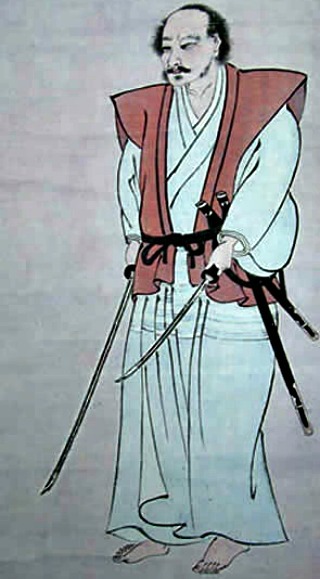
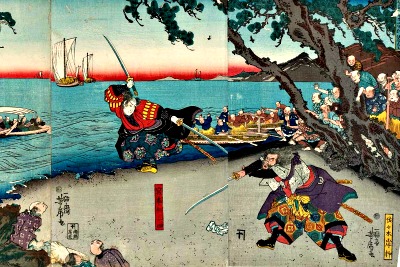
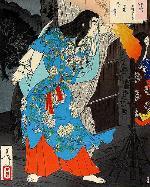
.jpg?timestamp=1581532949713)
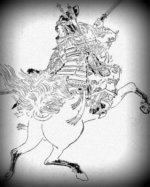
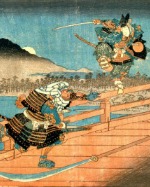
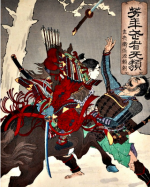
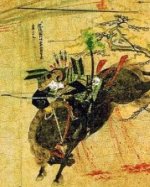
 thumb.jpg?timestamp=1581533579620)
